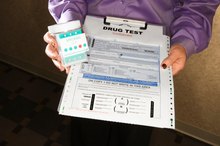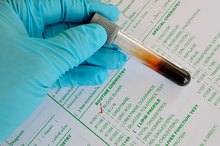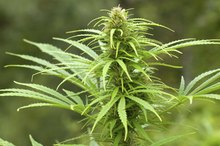What does fact checked mean?
At Healthfully, we strive to deliver objective content that is accurate and up-to-date. Our team periodically reviews articles in order to ensure content quality. The sources cited below consist of evidence from peer-reviewed journals, prominent medical organizations, academic associations, and government data.
The information contained on this site is for informational purposes only, and should not be used as a substitute for the advice of a professional health care provider. Please check with the appropriate physician regarding health questions and concerns. Although we strive to deliver accurate and up-to-date information, no guarantee to that effect is made.
What Drugs Are Tested for in a Urinalysis?
A urinalysis is a detailed examination of urine used to detect and measure compounds passing through the urine. Mayo Clinic explains that due to drug abuse posing a serious medical and social problem, drug testing aids in providing accurate information for medical care to occur. Urinalysis is also commonly used by employers to determine the eligibility of potential hires. The Medical College of Wisconsin indicates that the two forms of urine drug testing used are a screening test and a confirmatory test. The urine screening tests for presence of drugs or metabolites. The confirmatory test is necessary when a drug is suspected yet does not appear on the less discrete urine screening. The additional evaluation of urine is done by gas chromatography to identify the substance.
If you are experiencing serious medical symptoms, seek emergency treatment immediately.
Opioids
Legal opioids are prescribed as pain-relieving medications for a variety of medical conditions. Urinalysis tests for opiates, which is the broader category of the narcotic that includes the synthetic form of the drug referred to as opioids. Drugs such as codeine, oxycodone and morphine are prescription opioids, whereas heroin is an illicit opioid. According to Mayo Clinic, these drugs yield positive screens in a urinalysis, however, a confirmatory test is required to distinguish the specific drug due to the similarity of the metabolites that is not clarified by a simple screening alone. Opioids are detectable by urinalysis for up to three days after cessation of use.
- Legal opioids are prescribed as pain-relieving medications for a variety of medical conditions.
- Urinalysis tests for opiates, which is the broader category of the narcotic that includes the synthetic form of the drug referred to as opioids.
Cannabinoids
What Is Included in a 9 Panel Drug Screen?
Learn More
Cannabinoids are illegal and controlled substances, commonly known as marijuana. Urinalysis tests for cannabinoids to determine if these are present. The Medical College of Wisconsin explains that the specific ingredient tested in the urine is tetrahydrocannabinol. Screening alone does not distinguish marijuana from the synthetic and legal version of cannabinoid, known as dronabinol. MedlinePlus notes that tetrahydrocannabinol is detectable in the urine for up to 11 weeks after use, in consistent users of the drug 1.
- Cannabinoids are illegal and controlled substances, commonly known as marijuana.
- MedlinePlus notes that tetrahydrocannabinol is detectable in the urine for up to 11 weeks after use, in consistent users of the drug 1.
Cocaine
Cocaine is an illicit central nervous system stimulant, commonly tested for in a drug screen. Cocaine is snorted by nose as a powder, smoked as crack or melted into a liquid for injection. No matter what form of this drug is used, it is detected by a urinalysis. According to MedlinePlus, cocaine remains in the body anywhere from two days to 22 days after cessation, depending on consistency of use 1.
- Cocaine is an illicit central nervous system stimulant, commonly tested for in a drug screen.
Amphetamines
What Is an SAP 10-50 Test?
Learn More
Amphetamine screening includes the derivatives methamphetamines and ecstasy. Prescription drugs that may test positive for amphetamine include certain psychiatric medications such as dextroamphetamine or d-amphetamine. Mayo Clinic indicates a confirmatory test is required to distinguish the metabolites for specifying the amphetamine present in the urinalysis. Amphetamines generally take up to 48 hours to process out of the body after cessation of use.
- Amphetamine screening includes the derivatives methamphetamines and ecstasy.
Additional Drugs
The drug phencyclidine, or PCP, is included in a urinalysis due to the U.S. Department of Justice report of increased use of the drug in young adults. PCP is detectable for up to eight days after cessation of use. Urinalysis can also detect the presence of benzodiazepines and barbiturates. Both are available as legal prescriptions, however, each has a high propensity for nonlegal use.
- The drug phencyclidine, or PCP, is included in a urinalysis due to the U.S. Department of Justice report of increased use of the drug in young adults.
Related Articles
References
- MedlinePlus: Toxicology Screen
- National Institute on Drug Abuse: Cocaine
- Cleveland Clinic. Urinalysis. Updated July 2018.
- Park S, Lee S, Lee A, et al. Preoperative dipstick albuminuria and other urine abnormalities predict acute kidney injury and patient outcomes. Surgery. 2018;163(5):1178-1185. doi:10.1016/j.surg.2017.12.002
- MedlinePlus. Urinalysis. Updated February 2019.
- MedlinePlus. Urine 24-hour volume. Updated July 2017.
- MedlinePlus. Urinary catheters. Updated January 2019.
- Witte EC, Lambers heerspink HJ, De zeeuw D, Bakker SJ, De jong PE, Gansevoort R. First morning voids are more reliable than spot urine samples to assess microalbuminuria. J Am Soc Nephrol. 2009;20(2):436-43. doi:10.1681/ASN.2008030292
- KidsHealth from Nemours. Urine test: Automated dipstick urinalysis.
- Cleveland Clinic. Blood sugar tests.
- UCLA Health. Complete urinalysis. Updated June 2018.
- Revollo JY, Lowder JC, Pierce AS, Twilla JD. Urine discoloration associated with metronidazole a rare occurrence. J Pharm Technol. 2014;30(2):54–56. doi:10.1177/8755122513500921
- Cleveland Clinic. Urine changes. Updated January 2020.
- Cavanaugh C, Perazella MA. Urine sediment examination in the diagnosis and management of kidney disease: Core curriculum 2019. Am J Kidney Dis. 2019;73(2):258-272. doi:10.1053/j.ajkd.2018.07.012
- MedlinePlus. Clean catch urine sample. Updated January 2018.
- UK National Health Service. How should I collect and store a pee (urine) sample?. Updated August 2019.
- KidsHealth from Nemours. Urine Test: Routine Culture.
- MedlinePlus. Urine - abnormal color. Updated July 2019.
- Urology Care Foundation of the American Urological Association. The meaning behind the color of urine. Updated August 2018.
- Al-badr A, Al-shaikh G. Recurrent urinary tract infections management in women: A review. Sultan Qaboos Univ Med J. 2013;13(3):359-67. doi:10.12816/0003256
- Vaginal infections. Girls Health. US Department of Health and Human Services. Updated May 2014.
- Parnham A, Serefoglu EC. Retrograde ejaculation, painful ejaculation and hematospermia. Transl Androl Urol. 2016; 5(4): 592–601. doi:10.21037/tau.2016.06.05
- Najeeb S, Munir T, et al. Comparison of urine dipstick test with conventional urine culture in diagnosis of urinary tract infection. J Coll Physicians Surg Pak. 2015;25(2):108-10. doi: 02.2015/JCPSP.108110
- Ko DH, Jeong TD, Kim S, et al. Influence of vitamin C on urine dipstick test results. Ann Clin Lab Sci. 2015;45(4):391-5.
- Foley KF, Wasserman J. Are unexpected positive dipstick urine bilirubin results clinically significant? A retrospective review. Lab Med. 2014;45(1):59-61. doi:10.1309/lml85xx1qbercirn
- Delanghe J, Speeckaert M. Preanalytical requirements of urinalysis. Biochem Med (Zagreb). 2014;24(1):89-104. doi:10.11613/BM.2014.011
- American Urological Association. Diagnosis, Evaluation and Follow-up of Asymptomatic Microhematuria (AMH) in Adults (2016).
- MedlinePlus. Glucose in urine test. Updated February 2020.
- Hiorns MP. Imaging of the urinary tract: the role of CT and MRI. Pediatr Nephrol. 2011;26(1):59-68. doi:10.1007/s00467-010-1645-4
- American Cancer Society. Tests for bladder cancer. Updated January 2019.
- College of American Pathologists. (2016) CAP Accreditation Program: Urinalysis Checklist. Northfield, Illinois: College of American Pathologists.
- Pallin, D.; Ronan, C.; Montazeri, K. et al. Urinalysis in Acute Care of Adults: Pitfalls in Testing and Interpreting Results. Open Forum Infect Dis. 2014: 1(1): ofu019. DOI: 10.1093/ofid/ofu019.
Writer Bio
Aubri John has been a contributing researcher and writer to online physical and mental health oriented journals since 2005. John publishes online health and fitness articles that coincide with her licensed clinical skills in addictions, psychology and medical care. She has a master's degree in clinical social work and a Ph.D. in health psychology.








